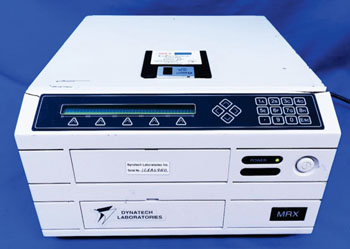Blood Test Detects Breast Cancer Spread Earlier
By LabMedica International staff writers
Posted on 12 May 2016
More sensitive, non-invasive tests are required for secondary breast cancer, which occurs when new tumors grow in the bone, liver, lung or brain, to make diagnosis easier and for treatment to begin as early as possible.Posted on 12 May 2016
Secondary breast cancer is difficult to diagnose before symptoms are experienced and occurs in up to a third of breast cancer patients, sometimes many years after seemingly successful treatment for localized, primary cancer that remained in the breast.

Image: The MRX microplate reader (Photo courtesy of Dynatech Medical Products).
Scientists at the University of Westminster (London, UK) collected serum samples from breast cancer patients were recruited onto the study nine to15 months post breast cancer diagnosis, whereupon the first of five annual venipunctures was performed. There were 207 patients who developed distant metastases by October 2012, of which 120 had available serum samples from year one and at least one other year of the study. In a nested case–control study of serum samples from breast cancer patients, of which 52 had developed a distant metastatic recurrence within five years post-diagnosis and 60 who had remained recurrence-free.
Enzyme-linked immunosorbent assays (ELISA’s) were used to quantify patient serum cadherin-5 (CDH5) levels and assess glycosylation by Helix pomatia agglutinin (HPA) binding. The reaction was monitored using a Dynatech MRX plate reader (Dynatech Medical Products, Alexandria, VA, USA), and following quenching the absorbance was read at 450 nm in a Wallac 1420 Victor 2 plate reader (Perkin Elmer, Beaconsfield, UK). Serum cancer antigen 15.3 (CA15.3), and carcinoembryonic antigen (CEA), and Vascular endothelial growth factor (VEGF) levels were also measured.
The investigators detected higher levels of a protein called CDH5 that had unusual sugars decorating its surface in women who went on to be diagnosed with secondary breast cancer over a year later. This indicates that the sensitivity of current blood tests could be improved upon for earlier diagnosis of secondary disease. Serum CDH5 levels and CDH5:HPA ratio values showed these biomarkers to be significantly elevated in patients with metastatic breast cancer, a finding which was paralleled by measurements of CA15.3, which is a more specific but less sensitive marker than CDH:HPA ratios.
Miriam Dwek, PhD, who leads the cancer group, said, “The blood test worked particularly well at identifying metastasis in a sub-group of patients with estrogen responsive breast cancers, which make up 70% of all breast cancers diagnosed. We are excited and hope to develop this test further so in the future there will be improved methods for the better monitoring of patients.” The study was published on March 24, 2016, in the journal British Journal of Cancer.
Related Links:
University of Westminster
Dynatech Medical Products









 assay.jpg)




